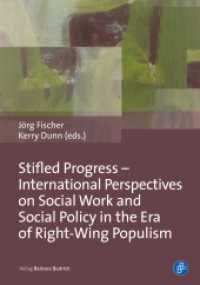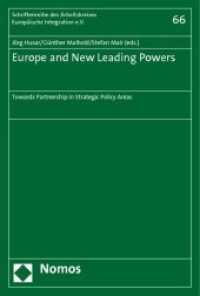- ホーム
- > 洋書
- > 英文書
- > Nature / Ecology
Full Description
This edited book provides critical insights into changing climate's impact on agriculture and innovative strategies for building resilience.
The agricultural sector is highly dependent on climatic conditions, is particularly vulnerable to the impacts of drought and heat stress. It has been notices that crop yields in Africa, Asia, and the Middle East are reduced by 15-35% when temperatures rise by 3-4 oC. The book explores the impacts of climate change on agriculture and how farmers can adapt their practices to overcome the dual threat of drought and heat stress on cereals, pulses, oilseeds, vegetables, and other allied sectors. One of the key themes of the book is the importance of smart water management in building agricultural resilience to drought and heat stress. By adeptly managing water resources and nurturing soil health through practices like cover cropping and reduced tillage, farmers bolster their resilience. Additionally, livestock management strategies are explored to combat reduced productivity and health issues due to heat stress. Harnessing the power of AI-assisted solutions, the book showcases how cutting-edge technology aids data-driven decisions on crop management and irrigation.
This book is a vital resource for farmers, researchers, policymakers, and those concerned about our food systems' future. It emphasizes the urgent need for climate-smart agricultural policies and technologies, offering prospects for sustainable practices and resilient food production.
Contents
Theme 1: Understanding the Impacts of Drought and Heat Stress on Agriculture
.- Chapter 1: Climate change and the incidence of drought and heat stress in agriculture
.- Chapter 2: Impact of Abiotic Stress on Cereal Crop Production
.- Chapter 3: Potential impacts of heat and drought on vegetable production and quality
.- Chapter 4: Drought and Heat Stress in Fruit Crops: Implications, Mitigation and Policy Perspectives
.- Chapter 5: Livestock Production under Drought and Heat stress
.- Chapter 6: Climate change and its impact on fisheries and Aquaculture
.- Chapter 7: Agroforestry and Climate Adaptation: Overcoming Drought and Heat Challenges
Theme 2: Mitigation and adaptation options for building resilience towards drought and heat stress
.- Chapter 8: Mitigating the impact of drought and heat stress on crop productivity and environmental sustainabilityovery
.- Chapter 9: Potential Mitigation of Drought and Heat Stress in Common Food Crops Using Indigenous Rhizobacterial Populations
.- Chapter 10:Influencing and Managing Abiotic Stresses in Cereals
.- Chapter 11:Varietal interventions and their significance in Rice-based cropping systems of drought-prone ecologies in Odisha
.- Chapter 12:Adapting Soil and Nutrient Management to a Changing Climate: Emerging Innovations and Policy Priorities
.- Chapter 13:Utilization of Nanotechnology For Mitigation of Drought and Heat Stress In Crop Plants
.- Chapter 14:New-generation Mitigation Practices for Drought Management in Rice
.- Chapter 15:Navigating Agricultural Drought: Building Resilience through Monitoring and Forecasting
.- Chapter 16:Machine Learning-led Solutions in Indian Agriculture: Case of Drought and Heat Stresses
Theme 3: Policies and Future Prospects
.- Chapter 17:Cultivating Resilience: A Policy Framework for Climate Smart Agriculture
.- Chapter 18:Food security and climate change: Policy implications
.- Chapter 19:Sustainable Agriculture and Climate Policy: Integrating Modern Technologies for Crop Stress Mitigation
.- Chapter 20:Socio-Economic Aspects and Future outlook for managing heat and drought stress in Agriculture and allied Sciences.








